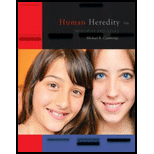
Concept explainers
Why do you think it has been so difficult to identify genes underlying schizophrenia?
Rachel asked to see a genetic counselor because she was concerned about developing schizophrenia. Her mother and maternal grandmother both had schizophrenia and were institutionalized for most of their adult lives. Rachel’s three maternal aunts are all in their 60s and have not shown any signs of this disease. Rachel’s father is alive and healthy, and his family history does not suggest any behavioral or genetic conditions. The genetic counselor discussed the multifactorial nature of schizophrenia and explained that many candidate genes have been identified that may be mutated in individuals with the condition. However, a genetic test is not available for presymptomatic testing. The counselor explained that based on Rachel’s family history and her relatedness to individuals who have schizophrenia, her risk of developing it is approximately 13%. If an altered gene is in the family and her mother carries the gene, Rachel has a 50% chance of inheriting it.
To describe: The difficulties to identify genes underlying schizophrenia.
Introduction: Schizophrenia is characterized by thought disorders, delusions, and anti-social behavior. This is much common in children and at least lasts for 6 months. Schizophrenia is found within a region of DNA located on chromosome 6. The genes underlying the disease are still unknown.
Explanation of Solution
Schizophrenia is a behavioral disorder that causes widespread human suffering. Several genetic studies have shown that hundreds of genes are linked to schizophrenia. Each gene contributes a small part to the risk of developing the disease.
Therefore, a mutation in a gene does not confirm the presence of schizophrenia. Similarly, if someone has schizophrenia with a mutation in a gene also does not mean that this mutation is responsible for the behavior of the respective person.
Hence, it is difficult to find genetic determinants underlying schizophrenia.
Want to see more full solutions like this?
Chapter 18 Solutions
Human Heredity: Principles and Issues (MindTap Course List)
- please draw in what the steps are given. Thank you!arrow_forwardplease draw in and fill out the empty slots from image below. thank you!arrow_forwardThere is a species of eagle, which lives in a tropical forest in Brazil. The alula pattern of its wings is determined by a single autosomal gene with four alleles that exhibit an unknown hierarchy of dominance. Genetic testing shows that individuals 1-1, 11-4, 11-7, III-1, and III-4 are each homozygous. How many possible genotypes among checkered eagles in the population?arrow_forward
- students in a science class investiged the conditions under which corn seeds would germinate most successfully. BAsed on the results which of these factors appears most important for successful corn seed germination.arrow_forwardI want to write the given physician orders in the kardex formarrow_forwardAmino Acid Coclow TABle 3' Gly Phe Leu (G) (F) (L) 3- Val (V) Arg (R) Ser (S) Ala (A) Lys (K) CAG G Glu Asp (E) (D) Ser (S) CCCAGUCAGUCAGUCAG 0204 C U A G C Asn (N) G 4 A AGU C GU (5) AC C UGA A G5 C CUGACUGACUGACUGAC Thr (T) Met (M) lle £€ (1) U 4 G Tyr Σε (Y) U Cys (C) C A G Trp (W) 3' U C A Leu בוט His Pro (P) ££ (H) Gin (Q) Arg 흐름 (R) (L) Start Stop 8. Transcription and Translation Practice: (Video 10-1 and 10-2) A. Below is the sense strand of a DNA gene. Using the sense strand, create the antisense DNA strand and label the 5' and 3' ends. B. Use the antisense strand that you create in part A as a template to create the mRNA transcript of the gene and label the 5' and 3' ends. C. Translate the mRNA you produced in part B into the polypeptide sequence making sure to follow all the rules of translation. 5'-AGCATGACTAATAGTTGTTGAGCTGTC-3' (sense strand) 4arrow_forward
 Human Heredity: Principles and Issues (MindTap Co...BiologyISBN:9781305251052Author:Michael CummingsPublisher:Cengage Learning
Human Heredity: Principles and Issues (MindTap Co...BiologyISBN:9781305251052Author:Michael CummingsPublisher:Cengage Learning Biology (MindTap Course List)BiologyISBN:9781337392938Author:Eldra Solomon, Charles Martin, Diana W. Martin, Linda R. BergPublisher:Cengage Learning
Biology (MindTap Course List)BiologyISBN:9781337392938Author:Eldra Solomon, Charles Martin, Diana W. Martin, Linda R. BergPublisher:Cengage Learning Biology Today and Tomorrow without Physiology (Mi...BiologyISBN:9781305117396Author:Cecie Starr, Christine Evers, Lisa StarrPublisher:Cengage Learning
Biology Today and Tomorrow without Physiology (Mi...BiologyISBN:9781305117396Author:Cecie Starr, Christine Evers, Lisa StarrPublisher:Cengage Learning





